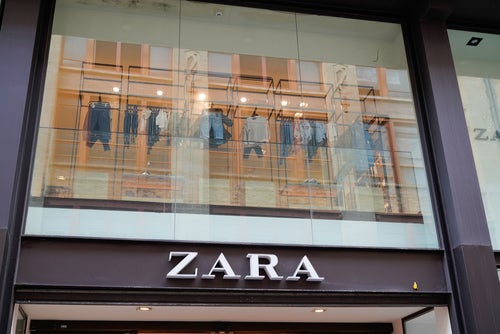
Spanish clothing giant Inditex says full-year sales in local currencies exceeded their pre-pandemic levels, boosted by online with revenue from its digital channels reaching EUR7.5bn (US$8.3bn) and accounting for 25.5% of total sales.
Inditex has published its results for fiscal 2021, marking the period from 1 February 2021 to 31 January 2022:
- Inditex reported revenue of EUR27.72bn, up 35.8% year on year. In local currencies, revenue was 3% above that of 2019 (net revenue was 2% lower).
- Revenue from online sales reached EUR7.5bn, accounting for 25.5% of total sales. Online sales expected to reach 30% of total sales in 2024.
- Net profit amounted to EUR3.24bn, marking year-on-year growth of 193%.
- Gross margin of 57.1% was up 123 basis points from 2020, marking the highest level in six years.
- At present, store and online sales between 1 February-13 March 2022 are tracking 33% higher year-on-year, which is 21% above the pre-Covid highs of 2019. In this period, sales in store and online in the Russian Federation and Ukraine represented approximately 5 percentage points of sales growth.
- Inditex outperformed its sustainability targets for 2021, specifically for the use of renewable energy – accounting for 91% of total consumption – and more sustainable raw materials, with Join Life products accounting for 47% of the total, 7 percentage points ahead of target.
Inditex’s executive chairman, Pablo Isla, said that, “after two years of pandemic, this set of results demonstrates the incredible ability to adapt to any circumstances that characterises all the people who work here, borne from their commitment and talent”.
The group’s CEO, Óscar García Maceiras, singled out “the leadership demonstrated by the company on the digital transformation front in recent years, this places us in an unrivalled position to offer an exceptional level of engagement with our quality and sustainable fashion”.
Commenting on the numbers, GlobalData retail analyst Pippa Stephens, says Inditex’s superior trend credentials and strong online proposition enabled it to successfully recover from the pandemic, with FY2021/22 sales in constant currencies exceeding FY2019/20 by 3%.
However, on a reported basis, she says revenue was still 2% below that of pre-pandemic levels, rising by EUR7.3bn to EUR27.7bn year-on-year.
“Though the group experienced steady growth throughout most of the year, Q4 was a problematic period, with revenue dipping 0.9% below FY2019/20 levels as the Omicron variant caused a notable decrease in footfall, as well as the cancellation of Christmas parties, which likely generated a sudden influx in returns,” Stephen says. “However, trade picked up again during the start of its Q1 FY2022/23, with constant currency sales from 1 February to 13 March surging 21% above the comparable period in FY2019/20, with the new spring/summer range gaining a particularly strong reaction from shoppers.
“This growth is despite Inditex’s ongoing store optimisation programme, as a result of which it now has 13% fewer stores than in FY2019/20, after shuttering its least profitable locations and refurbishing older ones to make them more appealing. Its significant investments in online have been crucial to the retailer’s success, with sales via this channel rising by 14%, on top of the strong growth of 77% experienced in the prior year, to reach 25.5% of total sales. As part of its online focus, it launched its ‘store mode’ digital functionality on its app in July 2021, bridging the gap between its stores and online platforms by providing real-time store stock levels and geolocation to allow shoppers to find specific items in stores. Inditex now hopes for its online sales to exceed 30% of total sales by 2024, so should focus its efforts on adjusting the style of its online images, as the unusual poses often adopted by models can make items difficult to browse.
“Of its brands, Zara continues to be Inditex’s star performer, and was the only one to exceed pre-pandemic sales in FY2021/22 on a reported basis (+0.1%), with its fast reaction to fashion trends driving its top of mind appeal among shoppers. This is helped by its vertically integrated supply chain, in which a large proportion of its suppliers are located in its home market of Spain, allowing it to have superior supply chain flexibility, and to be less impacted by the global supply chain crisis. In contrast, Massimo Dutti struggled the most, with revenue still 13.0% below that of FY2019/20 on a reported basis, as its formal offering remains less favoured by shoppers as they continue to work from home and office dress codes become more casual.
“In response to Russia’s invasion of Ukraine, Inditex decided to temporarily halt its instore and online operations in Russia at the beginning of March, mainly due to the difficulties of operating under sanctions, while its 79 stores in Ukraine also closed. The group has stated that the Russian market previously comprised around 8.5% of its total group EBIT, while sales in Russia and Ukraine represented approximately 5ppts of sales growth from 1 February to 13 March on a two-year basis, suggesting that the conflict will have a material impact on its total revenue this year. It may also create strain beyond these two countries, as rising commodity prices could impact the cost of textiles, contributing to further inflationary pressures for consumers.”
Inditex said in January it is investing EUR238m on a complex that will house Zara’s apparel sales and design teams in Arteixo, Spain.



